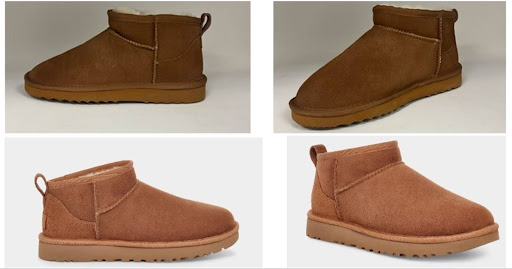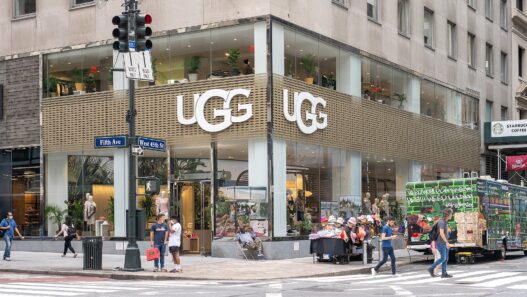As the weather turns crisp and shearling boots make their seasonal comeback, one of fashion’s cosiest icons is feeling the legal heat. UGG’s attempts to obtain exclusive rights to its Classic Ultra Mini boots and Tasman slippers have been unsuccessful. But let’s go back to the beginning and how the iconic UGG brand was born…
The Birth of an Icon, aka How UGG Stepped into the Spotlight
Deckers Outdoor Corporation, the parent company behind UGG, has been engaged in the design, distribution, marketing and sale of footwear since 1975. Deckers owns and markets its footwear products under several distinctive trademarked brands, including the (not-so) one-and-only UGG. This is one of the most well-recognised premium comfort and leisure shoe brands in the United States. UGG started life as a humble sheepskin boot before becoming a pop culture phenomenon in 2000, when UGG boots were featured on Oprah’s Favourite Things, where Oprah emphatically declared on national television how much she loves her UGG boots. [Case: 3:23-cv-04850-AMO, Complaint for Damages and Equitable Relief, p. 3.] She did it again in 2015, with the furry footwear being once again among her favourites. Since then, the popularity of UGG footwear has grown exponentially, embraced by celebrities such as Hailey Bieber, Kendall Jenner, Emily Ratajkowski, and Meghan Fox, among many others, who are regularly seen wearing the brand’s fuzzy footwear. The worldwide recognition as a premium brand and the overwhelming popularity of the UGG are due to Deckers’ continuous commitment to quality and excellence. [Case: 3:23-cv-04850-AMO, Complaint for Damages and Equitable Relief, p. 4.]
The Legal Battle Beneath the Sheepskin
The story began in summer 2023 when Deckers filed a lawsuit against Quince (Last Brand, Inc.). Among other things, Deckers alleged that Quince had crossed the line with its “Australian Shearling Mini Boots”, arguing that the design infringed the unregistered trade dress rights of the Classic Ultra Mini, as well as its ‘161 Patent. The company also claimed that “Australian Shearling Button Boot” mimicked the Bailey Button Boot, while the “Australian Shearling Clog Slipper” took a little too much inspiration from the iconic Tasman. [Case: 3:23-cv-04850-AMO, Complaint for Damages and Equitable Relief, p. 4.; Case: 3:23-cv-04850-AMO, Order Re Motions for Summary Judgement, p. 1.]

source: Case: 3:23-cv-04850-AMO, Complaint for Damages and Equitable Relief, pp. 5-6.
Back in 2020, Deckers introduced a fresh iteration of its UGG family, featuring the design elements protected under the “Classic Ultra Mini Trade Dress”. [Case: 3:23-cv-04850-AMO, Complaint for Damages and Equitable Relief, p. 5.] The trade dress in question is not just about comfort, but about a very specific look. It comprised of the following non-functional elements: an ankle-high silhouette, classic suede booty styling, an exaggerated, raised and exposed circular stitch pattern, exposed tufting, a raised and rounded vamp, a suede heel overlay, a fabric binding along the top of the boot and along the sole, a thick flat base, a top line that is higher in the front and lower in the back. Building on its portfolio of distinctive designs, Deckers describes the Tasman trade dress as including an embroidered braid around the opening of the upper, a raised front seam, a rounded dome-shaped toe, a brushed suede-like exterior, and a thick, flat outsole. [Case: 3:23-cv-04850-AMO, Defendant’s Notice of Motion and Motion for Partial Summary Judgement, p. 14.]
According to Deckers, the combination of the above characteristics is not functional in its entirety, is visually distinctive, and unique in the footwear industry. Its design is neither essential to its use nor purpose, nor does it affect the cost or quality of the show. [Case: 3:23-cv-04850-AMO, Complaint for Damages and Equitable Relief, p. 6.] Deckers claims that its competitor, Quince, exploited the reputation of the UGG Classic Ultra Mini model to market its own product without Deckers’ permission, creating a real risk of consumer confusion. Deckers has asked the Court to prohibit Quince from continuing to infringe on the Classic Ultra Mini Trade Dress, or any designs confusingly similar thereto [Case: 3:23-cv-04850-AMO, Complaint for Damages and Equitable Relief, p. 8.], as well as from violating the related ‘161 Patent [https://patentimages.storage.googleapis.com/20/bb/51/fc45bb48c055f9/USD927161.pdf]

source: Case: 3:23-cv-04850-AMO, Defendant’s Notice of Motion and Motion for Partial Summary Judgement, p. 34.
In response, Quince filed a motion for partial summary judgment, arguing that UGG’s designs were too generic to support trade dress protection because the Mini and Tasman trade dresses consist of overbroad, generalised elements that are so common in the industry and represent the basic form of sheepskin ankle-high boots and slippers. Furthermore, Quince stated that there could be no unfair competition without a protectable design and that the cited patent was invalid from the outset. [Case: 3:23-cv-04850-AMO, Defendant’s Notice of Motion and Motion for Partial Summary Judgement, p. 10.]
Defining the Look: What Trade Dress Really Protects
Trade dress came about in the US when the Supreme Court ruled that registrable trademarks could include not only words, images, and figures, but also trade dress, which originally only covered product packaging. However, in recent years, several appellate courts have extended it to the design of the product as well. Under trade dress, a product can only be protected if it is non-functional, and either inherently distinctive or has a “secondary meaning.” There are two types of functionality (utilitarian and aesthetic), and if the claimed trade dress falls into either type, it is unprotected by trademark law. The claimed trade dress has utilitarian functionality if it is essential to the use or purpose of the product, or affects its cost or quality. [Case: 3:23-cv-04850-AMO, Order Re Motions for Summary Judgement, p. 4.] Another part of the problem is that in order to protect trade dress, the designer must demonstrate that the distinctive design feature is not functional, even though it is generally accepted that clothing items are functional.
Although trade dress law can sometimes protect the design configuration and shape of the product itself, in some cases, obtaining a design patent may be more appropriate.
The Lanham Act protects trade dress that serves the same source-identifying function as a trademark. While it is possible to register trade dress as a trademark, most trade dress and product configurations are protected under 15 U.S.C. § 1125(a) without registration for practical reasons. Most trade dress is protected without registration.
How UGG’s Cosy Classics Ended Up in a Legal Storm
On 2 October, the U.S. District Court for the Northern District of California granted both parties’ motions.
Deckers’ previous claims are that its trade dresses are non-functional, as none of the trade dresses provide a utilitarian advantage over other models of boots or slippers in the market. In contrast, Quince cites the opinion of its expert, concluding that the boots have features that affect their cost or quality and are therefore functional. [Case: 3:23-cv-04850-AMO, Order Re Motions for Summary Judgement, p. 5.] Quince further argues that the Mini and Tasman trade dresses are so common in the industry that they cannot be said to identify a particular source. For example, it argues that Mini has at least 14 competitors in the market, while Tasman has 9, selling similar sheepskin ankle boots, moccasins or slippers. [Case: 3:23-cv-04850-AMO, Order Re Motions for Summary Judgement, p. 7.]
The Court ruled in favour of Quince, finding that UGG’s designs were too widely used and prevalent in the industry and marketplace to be attributed to a single source.
The Takeaways
While autumn and winter are all about staying warm, the legal climate has just become a lot colder for UGG…
Although Deckers lost its trade dress claims over the Mini and Tasman styles, parts of the case remain active. UGG may have conquered the streets, but the legal runway is far from settled. The design patent still stands, and the claim relating to the Bailey Button boot is ongoing. The ruling narrows Deckers’ enforcement options and underscores a broader principle in fashion law: even the most iconic designs can’t monopolize what has become part of the industry’s shared aesthetic language.
Timeline
To make sense of the twists, turns, and courtroom drama of the UGG dispute, I have laid out a timeline of the key milestones:

Dr. Kata Zsófia Prém

Dr. Kata Zsófia Prém is a PhD candidate at the University of Miskolc, Deák Ferenc Doctoral School of Law. Her research focuses on Intellectual Property Law, particularly copyright originality in fashion products. Her academic interests also encompass trademarks, designs, and various aspects of Fashion Law. She obtained her law degree in 2022. Fashion is her passion, and in her free time, she loves reading, baking, traveling, and spending quality time with her family and friends
















